Next year, Batman v Superman: Dawn of Justice will be the first live-action film to feature Wonder Woman. Played by Gal Gadot, the Amazon superhero is set to star in her own solo movie and at least one of the upcoming Justice League films. In October, Dawn of Justice producer Charles Roven said these movies will use the new origin presented in DC Comics’ “New 52” reboot (which began in 2011), rather than the story imagined by her original writer and creator William Moulton Marston. I think using the New 52 origin in general, much less in these films, is a mistake which diminishes the character and goes against why she was created in the first place.
Before we go any further – this is an opinion piece and I don’t expect or need everyone to agree with me. It’s also possible to enjoy a story or character and still find an aspect problematic.
Marston himself has been the subject of many discussions and writings. He was a feminist in a polyamorous relationship, a fan of bondage who wrote erotica featuring the Greek gods, whose work led to the development of the lie detector. Marston spoke openly of the potential for superhero comics to reach kids, teaching them values and opening their minds to new ideas. It got him a job as educational consultant at All-American Comics, then sister company of DC Comics (with which it later merged). He objected to the lack of superhero women in comics and pitched a patriotic character who would have “all the strength of a Superman plus all the allure of a good and beautiful woman.” This character became Diana, the Wonder Woman.
In her first appearance in 1941, it’s revealed the Amazons of myth are real people who eventually left “Man’s World” to live on a Paradise Island under the protection of Olympus. There they didn’t age and lived in peace, keeping up their fighting skills while developing science and technology more advanced than the rest of Earth. Later, circumstances lead Queen Hippolyta to send a representative into “Man’s World,” to fight evil such as the Nazis, while also spreading Amazon ideals to women who don’t know their own power. A contest is held and Princess Diana is chosen, the best and brightest Amazon.
 We’re told Diana was named after the goddess of Olympus, who was also her godmother. Months later, her origin expands in the pages of Sensation Comics #1. Diana is the only child on Paradise Island, born without the need of a father. Longing for a daughter, Hippolyta sculpted one out of clay and the goddess Aphrodite gave it life. Here, Marston gave us the Galatea myth with a superhero twist. It’s a unique origin story with strong symbolism wrapped around it. The Book of Genesis says Eve was created from one of Adam’s ribs, but Diana is created out of the soil and “dust of the ground” like Adam himself. She has a support network around her, a community of Amazons who are warriors, philosophers and scientists. They love her, yet life isn’t perfect and her unique birth and status always sets her slightly apart. As the first and only child born on Paradise Island, she is their avatar of the future. The Amazons develop futuristic technology, but Diana is the one person there who is growing up and changing over the years, the one who doesn’t wish to stay in isolation when she can look to the horizon instead.
We’re told Diana was named after the goddess of Olympus, who was also her godmother. Months later, her origin expands in the pages of Sensation Comics #1. Diana is the only child on Paradise Island, born without the need of a father. Longing for a daughter, Hippolyta sculpted one out of clay and the goddess Aphrodite gave it life. Here, Marston gave us the Galatea myth with a superhero twist. It’s a unique origin story with strong symbolism wrapped around it. The Book of Genesis says Eve was created from one of Adam’s ribs, but Diana is created out of the soil and “dust of the ground” like Adam himself. She has a support network around her, a community of Amazons who are warriors, philosophers and scientists. They love her, yet life isn’t perfect and her unique birth and status always sets her slightly apart. As the first and only child born on Paradise Island, she is their avatar of the future. The Amazons develop futuristic technology, but Diana is the one person there who is growing up and changing over the years, the one who doesn’t wish to stay in isolation when she can look to the horizon instead.
Marston would later tell comic historian Coulton Waugh, “Frankly, Wonder Woman is psychological propaganda for the new type of woman who should, I believe, rule the world.” You get a sense of that in her origin, even before she starts battling misogynists, Nazis, super-villains, conquerors and gods.
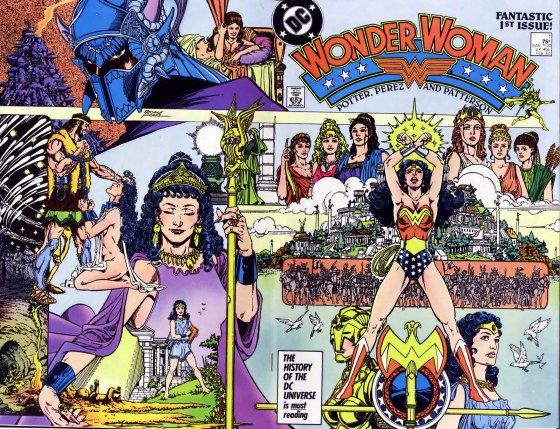 Wonder Woman’s origin was tweaked a few times over the decades. To keep it contemporary, writers stopped connecting Diana to World War II (which I also think is a mistake, but that’s another discussion). She was given greater power which set her further apart from other Amazons. The 1987 version of her origin, presented by Greg Potter and George Pérez, made the Amazons multi-racial and said they were originally women who had lived in various countries and time periods and had all been unjustly killed by men. The goddess of Olympus resurrected them and named them the new Amazon race, eventually giving them their Paradise Island home, named Themyscira. Diana was still made of clay but now she was named not after the goddess but rather a USAF pilot who had crashed on the island and then died while battling evil alongside the Amazons. The insignias on this pilot’s uniform, the eagle and American flag, inspired Wonder Woman’s own armor design. The new origin showed that Diana now owed power not just to Aphrodite but to several goddesses, as well as the god Hermes, while Gaea herself was the one to give her clay form life.
Wonder Woman’s origin was tweaked a few times over the decades. To keep it contemporary, writers stopped connecting Diana to World War II (which I also think is a mistake, but that’s another discussion). She was given greater power which set her further apart from other Amazons. The 1987 version of her origin, presented by Greg Potter and George Pérez, made the Amazons multi-racial and said they were originally women who had lived in various countries and time periods and had all been unjustly killed by men. The goddess of Olympus resurrected them and named them the new Amazon race, eventually giving them their Paradise Island home, named Themyscira. Diana was still made of clay but now she was named not after the goddess but rather a USAF pilot who had crashed on the island and then died while battling evil alongside the Amazons. The insignias on this pilot’s uniform, the eagle and American flag, inspired Wonder Woman’s own armor design. The new origin showed that Diana now owed power not just to Aphrodite but to several goddesses, as well as the god Hermes, while Gaea herself was the one to give her clay form life.
Despite these tweaks, the basic story remained: a girl immaculately born via love and magic, raised by a group of amazing women whose society represents both the future and the past, raised to be an intelligent, compassionate and formidable woman who is equally a warrior and a teacher. That last part is key. She likes a good fight, but for the sport and competition rather than violence and combat glory. In the crossover DC One Million, she suggested superheroes should have their own Olympics so they could learn to celebrate their powers instead of only using them for battle. How fun is that? That’s how she thinks.
For years, Marston showed Diana often reaching out to her enemies, sometimes even helping to rehabilitate them. Ares/Mars, the god of war, was her natural enemy in Martson’s eyes, who wrote Diana as a woman willing to fight, but preferring peace and understanding. For years now though, several creators have flipped the emphasis, basically telling us: “She wants peace, but she’ll fight you too!” That is a different idea and I think is part of what has led to this new origin. Along the same lines, there have been some who think Diana’s upbringing must make her a cultural throwback, a person so stiff and formal that she is also rather humorless. That is not at all what Marston intended and successfully delivered for years.
 There have also been instances where people have taken the wrong message from major stories. In 1996, the mini-series Kingdom Come showed a future where some superheroes lost their way, including Superman and Wonder Woman. This older, alternate universe version of Diana was colder, more a warrior, bringing a sword into battle because she believed some villains were simply monsters to be stopped. The story’s end showed her realizing this was a mistake, that she had lost touch with her principles. Yet some fans and creators ignored this and instead concluded yes, Wonder Woman should always act the way she did in Kingdom Come, she should always carry a sword and wear battle armor.
There have also been instances where people have taken the wrong message from major stories. In 1996, the mini-series Kingdom Come showed a future where some superheroes lost their way, including Superman and Wonder Woman. This older, alternate universe version of Diana was colder, more a warrior, bringing a sword into battle because she believed some villains were simply monsters to be stopped. The story’s end showed her realizing this was a mistake, that she had lost touch with her principles. Yet some fans and creators ignored this and instead concluded yes, Wonder Woman should always act the way she did in Kingdom Come, she should always carry a sword and wear battle armor.
Let’s be clear, I’m not against Wonder Woman ever having a sword or armor. I think that can be very cool, just as it’s very cool when Batman sometimes gets to have a sword fight. But I think those elements should be used to emphasize that certain battles are more serious than others, or more epic. If Diana is always walking around with a sword, it becomes less special. Not only is she powerful enough to not need it most of the time, but there’s an added problem when several artists draw her carrying a sword but without a scabbard. It visually signals that she’s itching for a fight, looking for an excuse to shed blood. Even Wolverine doesn’t walk around with his claws out all the time. Diana with a sword all the time is, to me, like seeing Superman carry a sword or a gun all the time. They’re powerful enough without such weapons and we know that.
In a 2005 story leading up to the crossover Infinite Crisis, Diana used lethal methods on a human villain named Maxwell Lord when she believed it was the only way to end a threat. Lord was physically restrained at the time with Wonder Woman’s lasso of truth and told her in no uncertain terms he’d have to be killed to resolve the dire situation. This led to conflict with Superman and Batman.
The Wonder Woman creative team wanted to emphasize that Batman was not furious at Diana but rather saddened that if someone as good and noble as she could corrupt their principles concerning the sanctity of life, then perhaps there was no hope for places like Gotham City. But this was outvoted by the higher ups and instead Batman was flat out angry that Diana took a human life, an act for which he would listen to no justification (which is out of character with how he has treated cops, military personnel and certain other heroes in the past). Likewise, when the Wonder Woman creative team brought up that Superman had killed three super-powered terrorists once because he’d seen no other choice, they were told this adventure was going to be wiped from continuity soon and could not be mentioned. Diana would be seen as the damaged one who had killed and Superman would not have any experience which would make him sympathize.
Following the death of Maxwell Lord, Infinite Crisis showed Wonder Woman, Batman, and Superman all realizing they had lost their way and gone down darker paths than they were meant for (in Diana’s case, partly because of the above-mentioned problem of thinking she could be warrior or teacher, but not both). Instead of Lord’s death being seen as an isolated incident in Wonder Woman’s life, it became a defining image for her in the minds of many. She wasn’t the woman who had once killed and still wrestled with the morality of the decision. For some, she was now simply a superhero who would kill when it made sense to her, a humorless version of Xena.
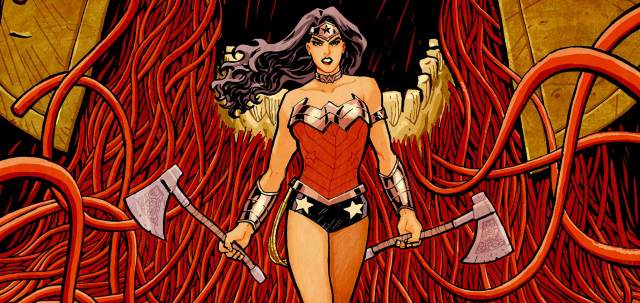 In 2010, Wonder Woman had a year-long story “The Odyssey” in which she became a vigilante raised on the streets, outside of Amazon principles, a character who branded her enemies when she punched them. This story was followed by an even more violent version of Diana, a conqueror who warred against men and was featured in the crossover Flashpoint for several months. Flashpoint then led into the 2011 “New 52” reboot across the DC Universe. I want to say there’s a lot to enjoy about the New 52 Wonder Woman saga which was presented by Brian Azarello and Cliff Chiang. I dislike how the Amazons were portrayed, but the series still delivered dramatic stories that often presented Diana as a woman with many facets, who would reach out in friendship and relied on intelligence even when others advised straightforward violence as the easiest solution. It was also great that other superheroes didn’t regularly stop by in Wonder Woman, showing the warrior princess could operate in her own world and be a leader. But I don’t think you needed to change the origin to write these stories. The new origin doesn’t work for her character.
In 2010, Wonder Woman had a year-long story “The Odyssey” in which she became a vigilante raised on the streets, outside of Amazon principles, a character who branded her enemies when she punched them. This story was followed by an even more violent version of Diana, a conqueror who warred against men and was featured in the crossover Flashpoint for several months. Flashpoint then led into the 2011 “New 52” reboot across the DC Universe. I want to say there’s a lot to enjoy about the New 52 Wonder Woman saga which was presented by Brian Azarello and Cliff Chiang. I dislike how the Amazons were portrayed, but the series still delivered dramatic stories that often presented Diana as a woman with many facets, who would reach out in friendship and relied on intelligence even when others advised straightforward violence as the easiest solution. It was also great that other superheroes didn’t regularly stop by in Wonder Woman, showing the warrior princess could operate in her own world and be a leader. But I don’t think you needed to change the origin to write these stories. The new origin doesn’t work for her character.
So what was this new origin? In the new continuity, Wonder Woman was raised thinking she’d been made of clay, but now there were other young girls who grew up with her on the island. Due to her unique origin, many of the other girls saw her as a freak, not a human but a thing made of clay. Even her close friend Aleka uses the slur “clay” as a way to hurt Diana after the princess reveals she actually wants to leave the island one day. While some writers like Gail Simone certainly played with the idea that some Amazons might feel this way and become enemies, Diana now lost the support system Marston envisioned and grew up as an outsider who never truly felt part of her community. Before, the Amazons had advanced technology and Wonder Woman herself was a scientist. Marston had her create the healing Purple Ray device. Some stories implied she made her famous invisible jet. In his own run, Phil Jimenez showed us a Diana who would spend some of her free time doing research in the Justice League labs, enthusiastically experimenting with alien technology. That’s all gone now. The Amazons are warrior women who only rely on methods and technology of the past.
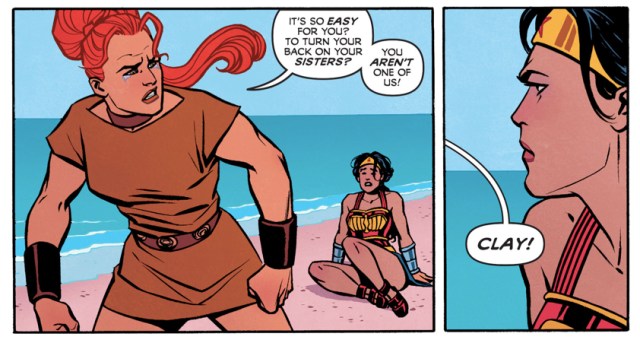 Along with all this, the new origin credits men with how powerful and formidable Diana is. Whereas before she had learned all her training from the Amazon women, her greatest teacher is now Ares. Then, as an adult, Wonder Woman learns she was never made of clay. This was a lie to cover-up the fact that her mother had slept with Zeus and fathered a child.
Along with all this, the new origin credits men with how powerful and formidable Diana is. Whereas before she had learned all her training from the Amazon women, her greatest teacher is now Ares. Then, as an adult, Wonder Woman learns she was never made of clay. This was a lie to cover-up the fact that her mother had slept with Zeus and fathered a child.
Diana was unique before, now she’s basically got the same origin as Herakles (traditionally seen as an enemy and rapist of her mother). Wonder Woman went from being someone raised in love, born and guided without the presence of men, given powers almost entirely by goddesses (Hermes being the exception who blessed her with speed and flight), to someone who got her powers from a father and truly became a warrior because of a male god who Marston considered to be her anti-thesis. I believe Marston would hate these changes. Should creators and companies be beholden only to what the original creator intended? No, times change, but I do think there’s a difference between updating a character and dismissing the purpose and core of their creation.
A major part of Azarello and Chiang’s Wonder Woman series was that Diana was now seen as sibling to many of the gods of Olympus, including Ares, and entered a family dynamic with them. That was interesting, but you don’t need Zeus to be her father for that to happen. If you go back to the original origin, then Diana already has two moms: Hippolyta and Aphrodite, a literal goddess. You could maintain the family connection with that. Or you could say Hera was the one to truly bless Wonder Woman with life, in which case she is still a sibling to gods like Ares. According to myth, Athena was born out of Zeus’s forehead and still counts as his daughter. These are gods of Olympus, other-dimensional beings whose physical bodies represent their minds and roles. They aren’t bound by what we understand as time and space, why would they be bound by biology and DNA? Why is Zeus having sex on a beach with Hippolyta the only way to consider Diana a child of Olympus? The old origin works fine for that interpretation.
There’s been an argument that making Diana a child of Zeus simplifies her origin. First, it doesn’t need it. A woman given power by Olympus, and raised by Amazons who have advanced science, decides to be a hero to the world rather than stay home where it’s safe. See? Did it in one sentence. Second, Warner Bros. and DC Comics have no problems adding layers and details to the origins of Batman and Superman in films such as Batman Begins and Man of Steel. The Flash used to just be this guy who liked comic books and was nice, so he became a superhero when he got powers. Years ago, his origin was changed to involve time travel, the murder of his mother and the unjust imprisonment of his father. Why is Wonder Woman the one who needs to keep things simple? Third, simplifying the story has resulted in the Amazons becoming less interesting and worthwhile. They are now people who seem to be stuck in a perception of the world that’s thousands of years out of date, instead of people who show a promising idea of what the future could be if we stopped fighting each other and embraced how amazing learning, understanding and science are. In such a case, I don’t want Diana to go around teaching Amazon philosophies, it sounds like it would be a terrible step backwards. It makes it seem like Wonder Woman would be better off turning her back on it and that’s terrible.
It feels too much like the origin was altered to make Diana more understandable to men and heteronormative standards. I also can’t help thinking the new origin was intended to justify how, outside of her own series and the new Sensation Comics anthology, most New 52 stories focus on Wonder Woman as a warrior with little interest or understanding that she can also be something else.
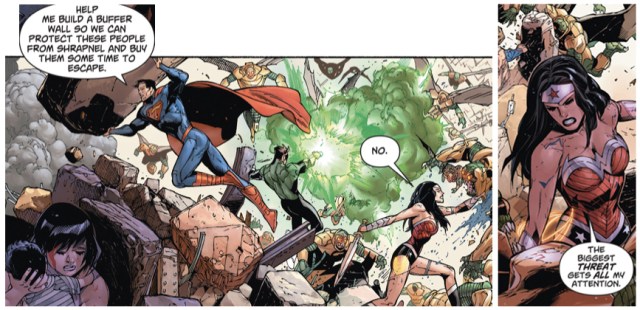 In the recent issue Superman/Wonder Woman #13, we see that during one of her earliest adventures, she is taken aback by how “weak” non-Amazons are. She ignores Superman’s pleas that she also protect innocents rather than focus only on killing monsters, and sneers at him when he says he trained under the guidance of a man despite the fact that she did in this continuity as well. Although she shows some sympathy to an injured bystander, she lectures him on being weak rather than acknowledging that he urgently needs medical care or helping him find it. Superman steps in, takes the bystander to a paramedic, and then lectures the smiling Wonder Woman about the need to consider the lives and safety of others.
In the recent issue Superman/Wonder Woman #13, we see that during one of her earliest adventures, she is taken aback by how “weak” non-Amazons are. She ignores Superman’s pleas that she also protect innocents rather than focus only on killing monsters, and sneers at him when he says he trained under the guidance of a man despite the fact that she did in this continuity as well. Although she shows some sympathy to an injured bystander, she lectures him on being weak rather than acknowledging that he urgently needs medical care or helping him find it. Superman steps in, takes the bystander to a paramedic, and then lectures the smiling Wonder Woman about the need to consider the lives and safety of others.
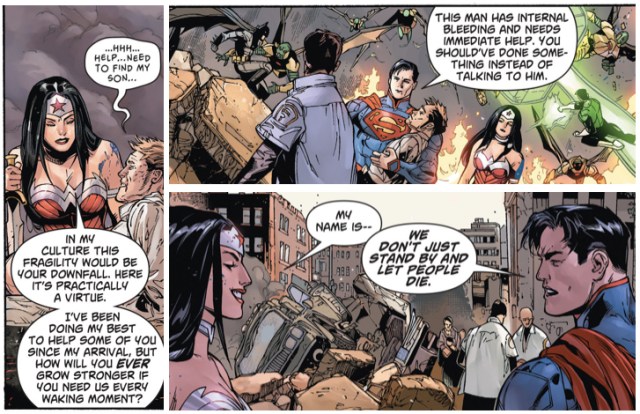 It’s great to see Superman give this lecture and point out the need to protect bystanders (especially considering that was a big issue for many with Zack Snyder’s Man of Steel). It is awful to think Wonder Woman would need such a lecture as an adult. But that’s what we got. Once again, she needs a man to tell her the truth about the world, this woman who was intended to be an avatar of truth and compassion. She can and should be flawed, but this was something else. In contrast to this warrior who has no time to coddle the weak, the new alternate universe “Earth 2” version of Wonder Woman has generally been shown to be a more majestic and hope-inspiring figure, one who is decades older than Bruce Wayne and Clark Kent and even saved their lives as children so they would be heroes later on (which is an amazing idea). It’s a shame that only an alternate universe version of Wonder Woman (who died in the same issue that introduced her) is allowed to be closer to what Marston would’ve enjoyed.
It’s great to see Superman give this lecture and point out the need to protect bystanders (especially considering that was a big issue for many with Zack Snyder’s Man of Steel). It is awful to think Wonder Woman would need such a lecture as an adult. But that’s what we got. Once again, she needs a man to tell her the truth about the world, this woman who was intended to be an avatar of truth and compassion. She can and should be flawed, but this was something else. In contrast to this warrior who has no time to coddle the weak, the new alternate universe “Earth 2” version of Wonder Woman has generally been shown to be a more majestic and hope-inspiring figure, one who is decades older than Bruce Wayne and Clark Kent and even saved their lives as children so they would be heroes later on (which is an amazing idea). It’s a shame that only an alternate universe version of Wonder Woman (who died in the same issue that introduced her) is allowed to be closer to what Marston would’ve enjoyed.
Thousands of people read a comic book. Millions will see the films Batman v Superman: Dawn of Justice, Wonder Woman, and Justice League. I wish these films well and I love that a director like Michelle MacLaren will be guiding Diana’s first feature film. But we’re already going onto the wrong track if we use the New 52 origin. Doing so can further cement ideas about Wonder Woman that Marston never intended and which, honestly, I don’t believe has as much impact or inspirational power (something superheroes are supposed to have).
In Wonder Woman’s own words (from a story by Gail Simone): “We have a saying, my people. Don’t kill if you can wound, don’t wound if you can subdue, don’t subdue if you can pacify, and don’t raise your hand at all until you’ve first extended it.”
With this origin and its justification of Diana as a warrior without remorse, we’re getting a character who sounds like a lot of other generic women warriors. Stop it. Don’t make her seem like the most familiar, played-out version of a female warrior. Wouldn’t it be great to see Diana as something different again, someone unique who made us all think that maybe, even though it’s often the more difficult path, it would be better to try and rely on compassion and understanding first? Wouldn’t it be great to see a woman whose greatest guidance came from her mother and adopted sisters rather than a god who occasionally shape-shifted and raped women in mythology and a god of war who was originally intended to be her arch-enemy? Wouldn’t it be great if we let her stand proudly with her own legend instead of being yet another demi-god like so many other warriors of myth?
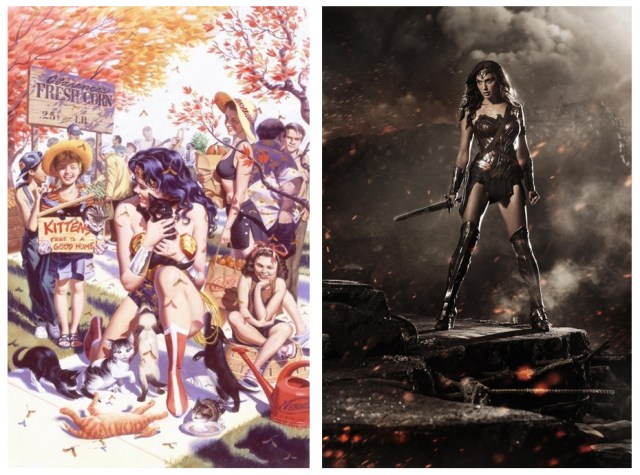 If this version of Wonder Woman’s origin works for you, ok. It doesn’t for me and I’m saddened by the potential I think is being squandered. You can disagree. These are just my thoughts.
If this version of Wonder Woman’s origin works for you, ok. It doesn’t for me and I’m saddened by the potential I think is being squandered. You can disagree. These are just my thoughts.
Alan Sizzler Kistler is the author of Doctor Who: A History. You can follow him via Twitter: @SizzlerKistler
Are you following The Mary Sue on Twitter, Facebook, Tumblr, Pinterest, & Google +?



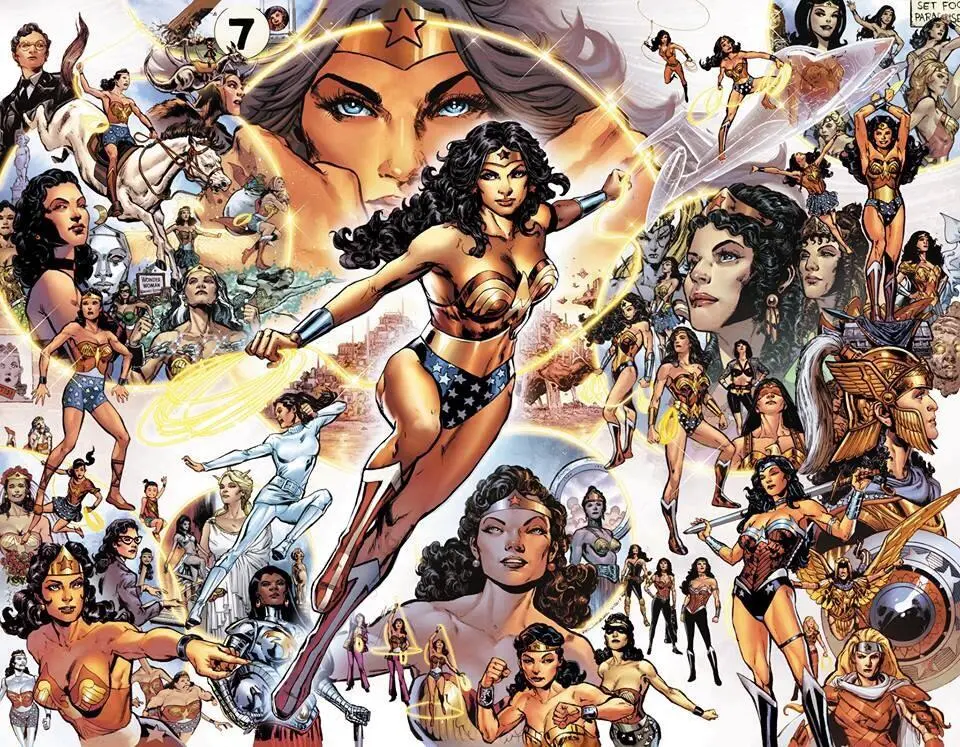




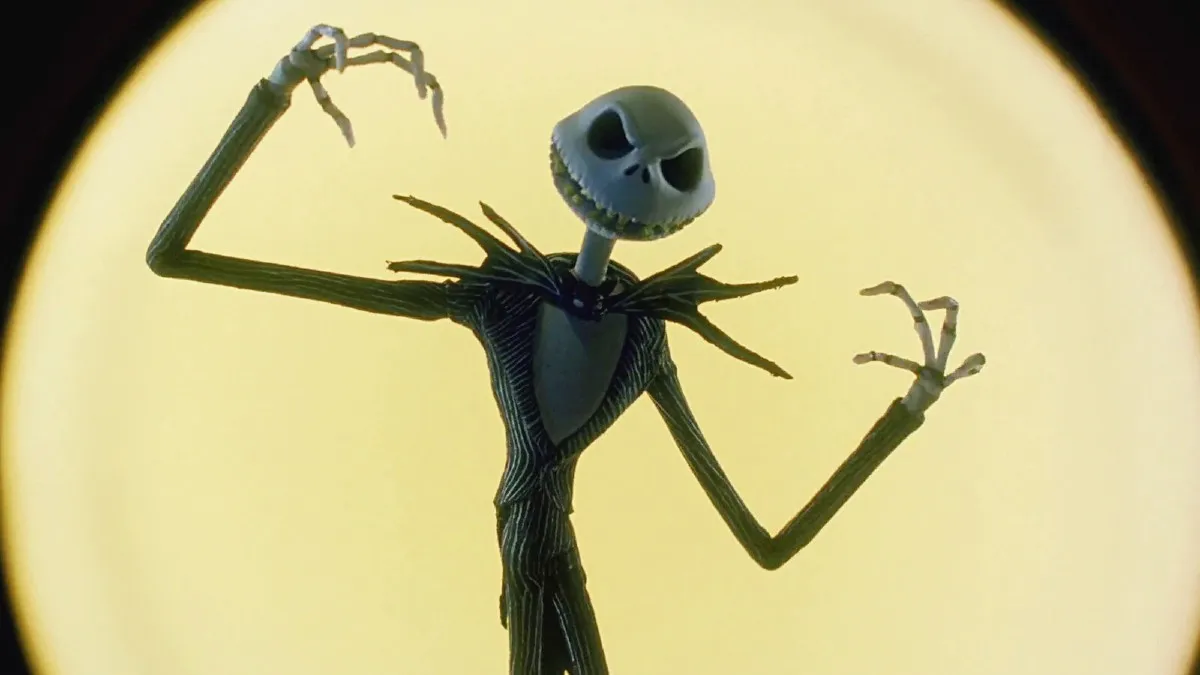
Published: Nov 25, 2014 01:53 pm